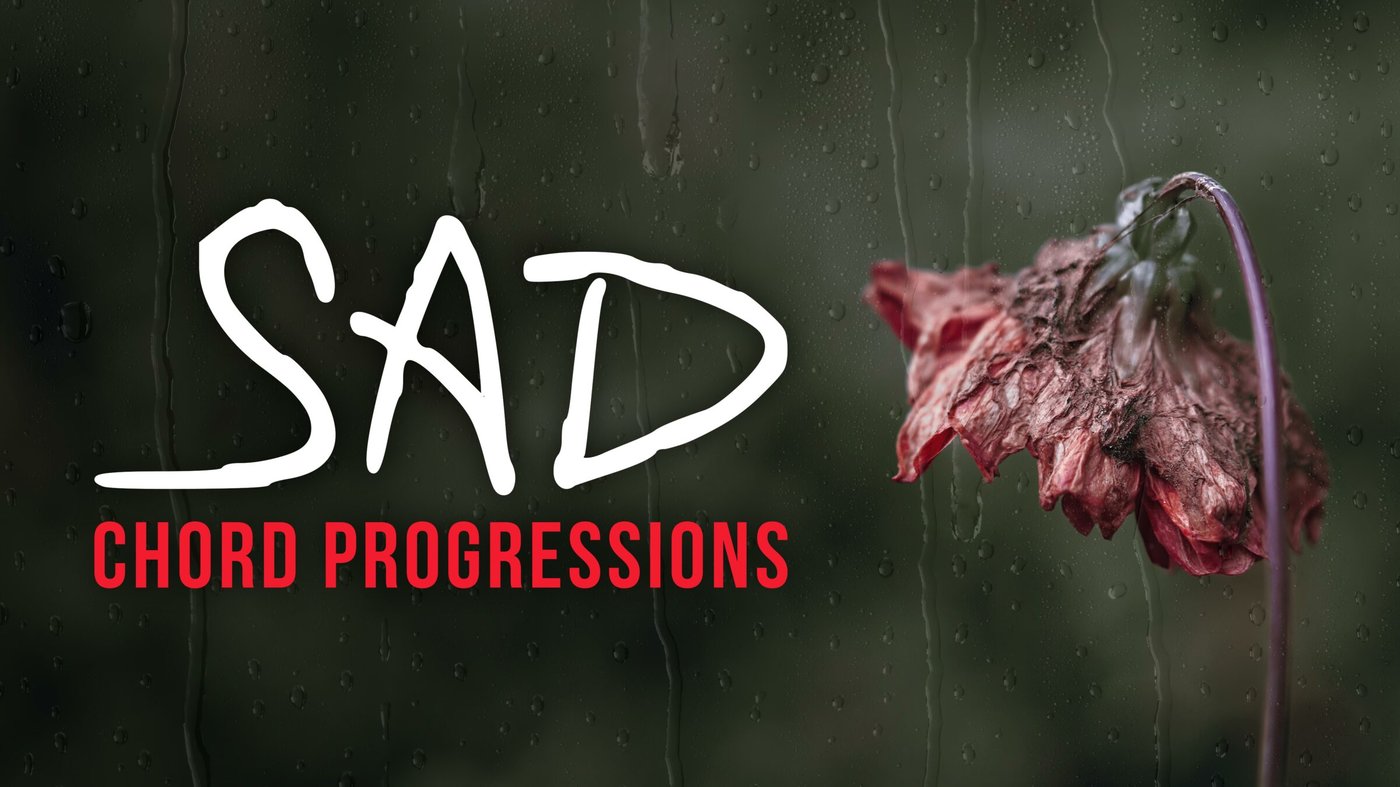
Sometimes, you just feel like feeling all the feelings. And sad chord progressions like vi-IV-I-V can help you express that.
What makes a chord progression sad? You might think it’s minor chords, but many of the chord progressions we’ll discuss don’t have many minor chords at all. Instead, the magic lies in how the chords are arranged and performed.
You’ll need a basic understanding of chord theory to get the most out of these progressions, but we’ll run over the basics and link you to some free resources.
Table of Contents:
Get exclusive interviews, fascinating articles, and inspiring lessons delivered straight to your inbox.
We’ve notated these sad chord progressions using the number system. This system is handy because it allows you to transpose a progression into any key.
The numbers just mean the scale degree upon which a chord is built. So, a “I” chord is built on the first note of the scale, and a “ii” chord is built on the second note of the scale.
In C major, the I chord is a C major triad and the ii chord is a D minor triad. The reason D is minor is because if you build a triad on D using the key signature of the C major scale, you’ll naturally get a minor chord.
Uppercase Roman numerals indicate major chords. Lowercase Roman numerals indicate minor chords.
For more details, check out:
The vi-IV-I-V has been nicknamed the “sensitive female chord progression” because of its popularity among woman singer-songwriters who use it for emotional songs. It’s one of pop music’s most popular chord progressions and can be thought of as a reshuffling of the I-V-vi-IV.
Songs that use this progression include:
This is a close cousin of the vi-IV-I-V, except we substitute the V with a major III. Another way to notate this progression is to use a minor key as the context: we’ll have i-VI-III-V, where i is the tonic minor.
In the minor context, the major chord at the end of this progression adds a lilt of intrigue. The V wants to resolve to the i, so the progression naturally sounds like it wants to go back to the beginning.
Songs that use this progression include:
David Bennett is one of our favorite content creators on YouTube and this article features many of his brilliant chord progression insights. If you like nerding out on music theory, don’t miss our Piano Bench episode with David: The Most Useful Piano Theory for Piano Players. And be sure to check out all the videos we’ve embedded here!

The “Creep” progression has an unmistakable sound. The minor-ing of the major chord at the end of the progression adds a strange touch to the progression.
With some good voice leading, this progression sounds extra satisfying. As David demonstrates here, you can make the third of the IV chord resolve to the third of the iv chord, then drop that down to the fifth of the I chord. The iv-I movement is also called a minor plagal cadence.
Songs that use this progression include:
Sad doesn’t have to mean slow! Songs that use the i-i-VI-V progression tend to be upbeat and fast but moody nonetheless. This progression succeeds in building up tension, appearing in songs like “Sweet Dreams Are Made of This” by Eurhythmics and “Havana” by Camila Cabello. Note that the numbers here refer to the minor key, so if we are in A minor, the chords would be Am-Am-F-C.
Other songs that use this progression include:
This minor key progression has an upward-pushing feel. The major IV chord gives it some extra flavor because ordinarily, the chord built on the fourth note of the natural minor scale should be minor. However, we briefly drift into Dorian mode and turn that minor chord into a major one. If we’re in A minor, you can think of A Dorian as raising the sixth degree (F) of the A natural minor scale. Hence, the IV chord (D) gets an F-sharp.
Songs that use this progression include:
This progression ends on a major V chord, which includes the raised seventh note of the harmonic minor scale. For example, if we’re in A minor, the v chord is ordinarily an E minor triad. However, in A harmonic minor, the seventh note (G) is raised a half-step. So by ending on an E major rather than an E minor triad, we drift into harmonic minor territory and end on a dark, almost doomed tone.
This progression is used in songs like:
David calls this progression the Aeolian Closed Loop because it is in the Aeolian mode or natural minor scale. It’s also a closed loop because we go back to the tonic. With three out of four chords being minor, this is a great progression to use if you’re looking for a dark and rich minor sound.
Songs that use this progression include:
This beautiful progression is used in one of our favorite Lana Del Rey songs, “Video Games.” It’s moody and dreamy and sounds amazing. It’s not super common in popular songs, so try it out. Maybe you’ll create the next big hit.
Songs we found that use this progression include:
Note that the numbers used here are in the context of a major key. So in C major, our chords would be Am, F, C, and Em.
This progression is wonderfully melancholic. We use it in one of our most popular videos of all time, “Create Emotion With 3 Notes” in which Lisa improvises three notes (B, C, and G) over this progression in A minor. It’s hauntingly beautiful! Try it yourself.
Songs that use this progression include:
This chord progression is stolen from one of the most famous piano songs of all time: Beethoven’s “Moonlight” Sonata! In the original C-sharp Minor intro to the piece, the chords go something like this: C#m-C#m/B-A-D/F#-G#-G#sus4-C#m.
Simplified, you can play C#m-A-D/F#-G# where the D chord is in first inversion.
The major version of this progression (I-vi-ii-V) is popular and it’s famously known as part of the Rhythm Changes. The minor version is rarer, but I did find a spooky song called “Martian Cowboy” by Kevin McLeod that perfectly evokes the dark mood.
> Moonlight Sonata Sheet Music & Tutorial
This is a truly haunting progression. It’s not very popular, but it famously makes an appearance in Sting’s “Shape of My Heart.” For extra effect, you can double the V at the end: play a Vsus4 that resolves to the V. To learn more about sus chords, check out this lesson.
Don’t like any of the listed chord progressions so far? Create your own! A great starting point is using the minor vi chord of a major key and then moving to the minor iii of that same key. So in G major, that’s Em to Bm. Then, try moving to other diatonic chords and see what happens.
Watch how Lisa experiments with this progression in the video above. For example, moving to chords IV or V adds a hopeful twist to the progression.
Songs with a vi-iii progression somewhere include:
This progression sounds dark and mysterious because it ends on the V, which means it stays unresolved. It can work well in a transitional or bridge section of a song. You can listen to how it sounds here.
Songs that use this progression include:
This one is interesting because we start in a happy place: the major IV. However, we end on a sad note: the minor vi. Because this progression climbs up the keys, it can sound like we’re going somewhere hopeful, only to be disappointed! A dramatic, tension-filled progression for sure.
Songs that use this progression include:
We hope you enjoy these sad chord progressions! Now go write that moody song and express allll your feelings.
Learn wherever you want, whenever you want, whatever you want. Join Pianote today and learn to play pop, classical, jazz, and more with real teachers.
Charmaine Li is a Vancouver writer who has played piano for over 20 years. She holds an Associate diploma (ARCT) from the Royal Conservatory of Music and loves writing about the ways in which music—and music learning—affects the human experience. Charmaine manages The Note. Learn more about Charmaine here.
/marketing/pianote/promos/april/banner-bg-m.webp)
We use cookies for traffic data and advertising. Cookie Policy »
/marketing/pianote/promos/april/banner-title.webp)